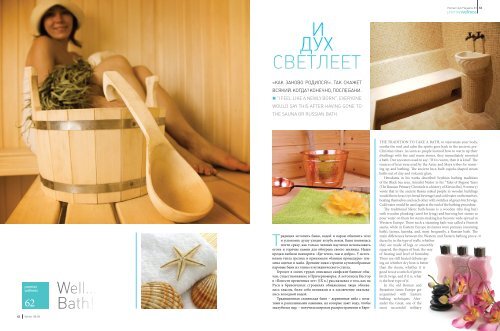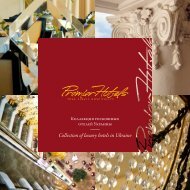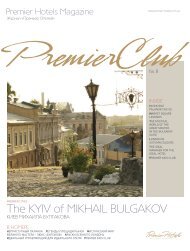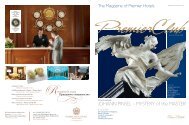CiTy wiTH a Coffee SHade
CiTy wiTH a Coffee SHade
CiTy wiTH a Coffee SHade
You also want an ePaper? Increase the reach of your titles
YUMPU automatically turns print PDFs into web optimized ePapers that Google loves.
Premier Club Magazine #3 63<br />
premierwellness<br />
И<br />
дух<br />
светлеет<br />
«Как заново родился!». Так скажет<br />
всякий. Когда? Конечно, после бани.<br />
• “I feel like a newly born”, everyone<br />
would say this after having gone to<br />
the sauna or Russian bath.<br />
premier<br />
wellness<br />
62<br />
Well…<br />
Bath!<br />
Традиция истопить баню, водой и паром обновить тело<br />
и успокоить душу уходит вглубь веков. Баня появилась<br />
почти сразу, как только человек научился использовать<br />
огонь и горячие камни для обогрева своего жилища. Наши<br />
предки любили повторять: «Где тепло, там и добро». У источников<br />
тепла грелись и принимали «банные процедуры» племена<br />
ацтеки и майя. Древние инки строили куполообразные<br />
паровые бани из глины и вулканического стекла.<br />
Геродот в своих трудах описывал скифские банные обычаи,<br />
существовавшие в Причерноморье. А летописец Нестор<br />
в «Повести временных лет» (IX в.) рассказывал о том, как на<br />
Руси в бревенчатых строениях обнаженные люди обливались<br />
квасом, били себя вениками и в заключение окатывались<br />
холодной водой.<br />
Традиционная славянская баня – деревянная изба с полатями<br />
и раскаленными камнями, на которые льют воду, чтобы<br />
заклубился пар, – получила широкое распространение в Евро-<br />
The tradition to take a bath, to rejuvenate your body,<br />
soothe the soul and calm the spirits goes back to the ancient, pre-<br />
Christian times. As soon as people learned how to warm up their<br />
dwellings with fire and warm stones, they immediately invented<br />
a bath. Our ancestors used to say: “If it is warm, then it is kind”. The<br />
sources of heat were used by the Aztec and Maya tribes for warming<br />
up and bathing. The ancient Inca built cupola-shaped steam<br />
baths out of clay and volcanic glass.<br />
Herodotus in his works described Scythian bathing traditions<br />
of the Black Sea area. Annalist Nestor in his “Tales of Bygone Years<br />
(The Russian Primary Chronicle is a history of Kievan Rus’, 9 century)<br />
wrote that in the ancient Russia naked people in wooden buildings<br />
would throw kvas (rye-bread beverage) and cold water on themselves,<br />
beating themselves and each other with switches of green birch twigs.<br />
Cold water would be used again at the end of the bathing procedure.<br />
The traditional Slavic bath-house is a wooden izba (log hut)<br />
with wooden planking (used for lying) and burning hot stones to<br />
pour water on them for steam-making has become wide-spread in<br />
Western Europe. There such a steaming bath was called a Finnish<br />
sauna, while in Eastern Europe its names were parnaya (steaming<br />
bath), laznya, lazenka, and, most frequently, a Russian bath. The<br />
main differences between the Western and Eastern bathing procedures<br />
lie in the type of walls, whether<br />
they are made of logs or smoothly<br />
squared, the degree of heat, the way<br />
of heating and level of humidity.<br />
There are still heated debates going<br />
on whether dry heat is better<br />
than the steam, whether it is<br />
good to use a switch of green<br />
birch twigs, and if it is, what<br />
is the best type of it.<br />
In the old Roman and<br />
Byzantine times Europe got<br />
acquainted with Eastern<br />
bathing techniques. Alexander<br />
the Great, one of the<br />
most successful military<br />
62<br />
Winter ‘08-09












